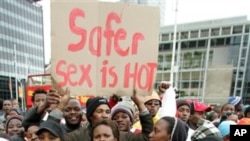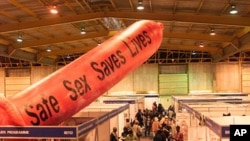A president who denied that HIV caused AIDS, and so banned the use of life-saving antiretroviral (ARV) medicines in public health facilities. A health minister who declared ARVs to be “poison” and instead advocated garlic and potatoes as cures for HIV.
During this period in South Africa, which lasted from 1999 until a court ordered the government to give ARVs to HIV-infected people in 2004, more than 330,000 people died of AIDS-related illnesses, according to a study by Harvard University.
Despite their legal obligations, President Thabo Mbeki and his health minister Manto Tshabalala-Msimang continued to resist a large-scale roll out of ARVs until they were both ousted from their positions in 2008.
Health activist group, the Treatment Action Campaign, said two million South Africans died “prematurely” of AIDS during President Mbeki’s tenure. It maintained that many of these deaths could have been prevented had the government facilitated wider access to ARVs.
Phumelele Dlamini almost joined the list of fatalities. Diagnosed with HIV in 1995 after giving birth, the Soweto resident and her son had no access to ARVs for almost a decade.
“We were dying. I still don’t know how we survived,” she recalled. “At that stage in South Africa death from AIDS was certain. The only question you asked yourself as an HIV-infected person was, ‘How much time do I have left?’ I never thought that things would change.”
But change has indeed come, and it has been radical … to the point where South Africa now has the largest public sector ARV treatment program in the world.
According to UNAIDS, there were 1.5 million people on state-sponsored ARVs in the country in 2011, but medical sources said this figure has since increased to 1.7 million.
Dlamini and her son are two of these ARV recipients.
“Right now, we’re living positively, and we’re taking our ARVs. I can say life is good,” she told VOA. “Drinking the ARVs is the only thing that I know that keeps people like me alive. I don’t like doing it, but it has given me life.”
Scientific approach
The appointment of Aaron Motsoaledi as health minister in May 2009 heralded a new era in South Africa’s response to its HIV epidemic. Health workers in South Africa describe the medical doctor from Limpopo province as a “man of science, not superstition” and a stark contrast to his predecessor.
“He speaks softly. He listens. When we activists disagree with him, he doesn’t shout and scream. He’s just a nice man,” said Dlamini, who is also an HIV counselor and is well-known in Soweto for her advocacy around the disease.
Dr. Kevin Rebe, a medical director who monitors South Africa’s progress in combating HIV for the Anova Health Institute, said, “Aaron Motsoaledi really does seem to have a firm grasp of what the HIV issues are...When you listen to him speak he’s coming from a very educated and researched position, which I think is quite confidence inspiring.”
He added that health providers now felt comfortable using science to treat HIV, unlike previously. “The science has helped us to allay fears associated with being diagnosed positive,” said Rebe. “Somebody who’s diagnosed as HIV positive today faces a very different level of stress than maybe five years ago in South Africa because the disease is publicized, treatment is publicized, people know it’s not a death sentence.”
Rising infections
But, while treatment has advanced significantly in recent years, South Africa remains the country with the highest number of people living with HIV – about 5.5 million. And, according to fieldworkers and health NGOs, infections are increasing.
“Our pool of people living with HIV is growing, not shrinking,” said Rebe.
He described the picture of where South Africa stood today in terms of HIV as “problematic,” explaining, “When you roll out big ARV programs like ours, obviously people don’t die of AIDS. They live with HIV for a lot longer. So what’s actually happening in the country is that there’s just this ever growing pool of people living positive, living with HIV and AIDS, and requiring healthcare. And obviously that’s an unsustainable situation long term because eventually the pool gets too big for your taxpayer allocation to healthcare to sustain it.”
He said South Africa was in urgent need of better HIV prevention programs. Dlamini agreed, saying, “We can’t carry on throwing pills at the problem and praising ourselves forever for treating HIV. We now have to prevent new infections and from what I see every day on the ground, we are not.”
She said although there was much more awareness about HIV and how it was spread, ignorance levels around the virus remained “shockingly high” in South Africa.
“It’s still not clear what the government is doing in just making sure that people are practicing safe sex and that people understand the importance of even knowing their (HIV) status,” said Dlamini.
However, Motsoaledi pointed out that he and President Jacob Zuma had in 2010 launched an HIV counseling and testing campaign that had resulted in 14 million people being tested and counseled for HIV, and that condoms were available for free at government health facilities across the country.
Crisis in public healthcare sector
Rebe said a largely dysfunctional public healthcare system was severely hampering South Africa’s attempts to successfully battle HIV. He maintained, “The healthcare system clearly is broken.”
Hospitals and clinics often run out of ARVs due to government failing to pay suppliers, for example. “This is happening all over South Africa. Now, if people don’t take their ARVs at the proper times they become resistant to them and that has terrible consequences. They get very ill, and some die,” said Dlamini.
The clinic where Rebe works at Woodstock in Cape Town has also endured an ARV shortage. “For days and days and days, we had queues outside, around the block recently,” he said. “Patients in our clinic were arriving and being told ‘Come back tomorrow for your ARVs.’ Now that’s unacceptable and it will negatively impact on peoples’ treatment success if they’re missing doses because of distribution problems.”
But Rebe added that drug supply chains were “generally” much better in the cities and bigger towns than in South Africa’s isolated rural regions.
He said the HIV epidemic had “completely overwhelmed” South Africa’s primary healthcare clinics. “These facilities are just full of really sick patients now because of the delays we had in initiating ARV programs in the country and because of people not accessing those programs,” he explained.
The fact that South Africa was managing such a large treatment program, said Rebe, was creating “ongoing logistical challenges” that were worsened by “poor management structures” and “poor logistic operations backup.”
He commented, “This definitely impacts negatively on peoples’ health.”
Dehumanizing stigma
Rebe said stigma remained the biggest barrier to healthcare access for HIV-infected people in South Africa. “Communities and to some extent health providers continue to stigmatize people with HIV. Discrimination is still keeping some South Africans away (from being tested and treated for HIV).”
With regard to stigma, it’s the media that’s a key battleground in South Africa, said Melissa Meyer, of the HIV and AIDS Media Project at Wits University in Johannesburg.
“The sense that we get from monitoring the media is that journalists are becoming better with engaging with HIV. But there are still examples of unsophisticated journalism and sometimes (careless) coverage. And we find that in that case, the biggest culprit usually is sensationalism,” said Meyer.
She highlighted a recent example from a tabloid newspaper which ran an article on an HIV-positive sex worker. “Her dying wish was to meet her idol, a gospel singer. The article completely neglected to mention that ART (antiretroviral therapy) rendered HIV a chronic condition and that HIV infection doesn’t necessarily equate to ‘AIDS death.’ Instead, it just ran with the idea that this sex worker was at death’s door on account of her being HIV-positive.”
Meyer said some newspapers continued to publish misleading and stigmatizing headlines – “often when the article itself is in fact quite accurate and sensitive. Again, there’s a recent example from a story in a local tabloid. The article itself was technically correct, but the headline read, ‘Teacher Bullies AIDS Girl.’ Calling a student an ‘AIDS Girl’ of course is extremely dehumanizing and very stigmatizing.”
Meyer added, “While we understand that newspapers are going to try to sell the news and so sometimes hype it up a bit, in the context of HIV it very quickly runs the risk of driving people who are living with HIV underground and away from safe sex practices.”
‘Ticking time bomb’
While Dlamini said there was “no doubt” that South Africa was managing its AIDS epidemic “a world better” than in the past, she remained “very, very concerned” about certain aspects of it.
“It’s the young people with HIV in this country that I am most worried about,” she emphasized. “We don’t see any programs in place to support and guide kids who were born (in the 1990s and early 2000s) with HIV. How do you think they feel, knowing that they could have been born HIV-free, but were not because of a government that refused to give their mothers ARVs? I can tell you through personal experience that they feel very angry and very depressed. They need help, but they are not getting it.”
Dlamini added that stigma was preventing many young people in South Africa from disclosing that they were infected with HIV.
“This is a ticking time bomb!” she exclaimed. “These kids are at the stage whereby they can go outside and have (unprotected) sex with other kids who are actually HIV-negative. That can actually spread the virus…and it’s happening as we speak.”
‘Conspiracy of silence’
Dlamini said many rural parts of South Africa that she’d visited remained “untouched” by positive developments in the sphere of HIV in the cities.
She explained, “Because of ignorance and stigma, rural people are not being tested and they are infecting one another like hell. There’s still a conspiracy of silence around HIV in many parts of our country. People are still scared of the word ‘HIV.’ Some people are actually dying (of AIDS) inside their homes because they’re afraid to even go to clinics and get checked.”
Thus, for Dlamini, a vision of an HIV-free generation of South Africans is “just a dream” at this stage.
But then she hesitated, and laughed, “South Africa is a place where the impossible becomes possible. The fact that I am alive today proves that. And people thought apartheid would destroy us, but it didn’t. I don’t think AIDS will achieve what apartheid did not.”
During this period in South Africa, which lasted from 1999 until a court ordered the government to give ARVs to HIV-infected people in 2004, more than 330,000 people died of AIDS-related illnesses, according to a study by Harvard University.
Despite their legal obligations, President Thabo Mbeki and his health minister Manto Tshabalala-Msimang continued to resist a large-scale roll out of ARVs until they were both ousted from their positions in 2008.
Health activist group, the Treatment Action Campaign, said two million South Africans died “prematurely” of AIDS during President Mbeki’s tenure. It maintained that many of these deaths could have been prevented had the government facilitated wider access to ARVs.
Phumelele Dlamini almost joined the list of fatalities. Diagnosed with HIV in 1995 after giving birth, the Soweto resident and her son had no access to ARVs for almost a decade.
“We were dying. I still don’t know how we survived,” she recalled. “At that stage in South Africa death from AIDS was certain. The only question you asked yourself as an HIV-infected person was, ‘How much time do I have left?’ I never thought that things would change.”
But change has indeed come, and it has been radical … to the point where South Africa now has the largest public sector ARV treatment program in the world.
According to UNAIDS, there were 1.5 million people on state-sponsored ARVs in the country in 2011, but medical sources said this figure has since increased to 1.7 million.
Dlamini and her son are two of these ARV recipients.
“Right now, we’re living positively, and we’re taking our ARVs. I can say life is good,” she told VOA. “Drinking the ARVs is the only thing that I know that keeps people like me alive. I don’t like doing it, but it has given me life.”
Scientific approach
The appointment of Aaron Motsoaledi as health minister in May 2009 heralded a new era in South Africa’s response to its HIV epidemic. Health workers in South Africa describe the medical doctor from Limpopo province as a “man of science, not superstition” and a stark contrast to his predecessor.
“He speaks softly. He listens. When we activists disagree with him, he doesn’t shout and scream. He’s just a nice man,” said Dlamini, who is also an HIV counselor and is well-known in Soweto for her advocacy around the disease.
Dr. Kevin Rebe, a medical director who monitors South Africa’s progress in combating HIV for the Anova Health Institute, said, “Aaron Motsoaledi really does seem to have a firm grasp of what the HIV issues are...When you listen to him speak he’s coming from a very educated and researched position, which I think is quite confidence inspiring.”
He added that health providers now felt comfortable using science to treat HIV, unlike previously. “The science has helped us to allay fears associated with being diagnosed positive,” said Rebe. “Somebody who’s diagnosed as HIV positive today faces a very different level of stress than maybe five years ago in South Africa because the disease is publicized, treatment is publicized, people know it’s not a death sentence.”
Rising infections
But, while treatment has advanced significantly in recent years, South Africa remains the country with the highest number of people living with HIV – about 5.5 million. And, according to fieldworkers and health NGOs, infections are increasing.
“Our pool of people living with HIV is growing, not shrinking,” said Rebe.
He described the picture of where South Africa stood today in terms of HIV as “problematic,” explaining, “When you roll out big ARV programs like ours, obviously people don’t die of AIDS. They live with HIV for a lot longer. So what’s actually happening in the country is that there’s just this ever growing pool of people living positive, living with HIV and AIDS, and requiring healthcare. And obviously that’s an unsustainable situation long term because eventually the pool gets too big for your taxpayer allocation to healthcare to sustain it.”
He said South Africa was in urgent need of better HIV prevention programs. Dlamini agreed, saying, “We can’t carry on throwing pills at the problem and praising ourselves forever for treating HIV. We now have to prevent new infections and from what I see every day on the ground, we are not.”
She said although there was much more awareness about HIV and how it was spread, ignorance levels around the virus remained “shockingly high” in South Africa.
“It’s still not clear what the government is doing in just making sure that people are practicing safe sex and that people understand the importance of even knowing their (HIV) status,” said Dlamini.
However, Motsoaledi pointed out that he and President Jacob Zuma had in 2010 launched an HIV counseling and testing campaign that had resulted in 14 million people being tested and counseled for HIV, and that condoms were available for free at government health facilities across the country.
Crisis in public healthcare sector
Rebe said a largely dysfunctional public healthcare system was severely hampering South Africa’s attempts to successfully battle HIV. He maintained, “The healthcare system clearly is broken.”
Hospitals and clinics often run out of ARVs due to government failing to pay suppliers, for example. “This is happening all over South Africa. Now, if people don’t take their ARVs at the proper times they become resistant to them and that has terrible consequences. They get very ill, and some die,” said Dlamini.
The clinic where Rebe works at Woodstock in Cape Town has also endured an ARV shortage. “For days and days and days, we had queues outside, around the block recently,” he said. “Patients in our clinic were arriving and being told ‘Come back tomorrow for your ARVs.’ Now that’s unacceptable and it will negatively impact on peoples’ treatment success if they’re missing doses because of distribution problems.”
But Rebe added that drug supply chains were “generally” much better in the cities and bigger towns than in South Africa’s isolated rural regions.
He said the HIV epidemic had “completely overwhelmed” South Africa’s primary healthcare clinics. “These facilities are just full of really sick patients now because of the delays we had in initiating ARV programs in the country and because of people not accessing those programs,” he explained.
The fact that South Africa was managing such a large treatment program, said Rebe, was creating “ongoing logistical challenges” that were worsened by “poor management structures” and “poor logistic operations backup.”
He commented, “This definitely impacts negatively on peoples’ health.”
Dehumanizing stigma
Rebe said stigma remained the biggest barrier to healthcare access for HIV-infected people in South Africa. “Communities and to some extent health providers continue to stigmatize people with HIV. Discrimination is still keeping some South Africans away (from being tested and treated for HIV).”
With regard to stigma, it’s the media that’s a key battleground in South Africa, said Melissa Meyer, of the HIV and AIDS Media Project at Wits University in Johannesburg.
“The sense that we get from monitoring the media is that journalists are becoming better with engaging with HIV. But there are still examples of unsophisticated journalism and sometimes (careless) coverage. And we find that in that case, the biggest culprit usually is sensationalism,” said Meyer.
She highlighted a recent example from a tabloid newspaper which ran an article on an HIV-positive sex worker. “Her dying wish was to meet her idol, a gospel singer. The article completely neglected to mention that ART (antiretroviral therapy) rendered HIV a chronic condition and that HIV infection doesn’t necessarily equate to ‘AIDS death.’ Instead, it just ran with the idea that this sex worker was at death’s door on account of her being HIV-positive.”
Meyer said some newspapers continued to publish misleading and stigmatizing headlines – “often when the article itself is in fact quite accurate and sensitive. Again, there’s a recent example from a story in a local tabloid. The article itself was technically correct, but the headline read, ‘Teacher Bullies AIDS Girl.’ Calling a student an ‘AIDS Girl’ of course is extremely dehumanizing and very stigmatizing.”
Meyer added, “While we understand that newspapers are going to try to sell the news and so sometimes hype it up a bit, in the context of HIV it very quickly runs the risk of driving people who are living with HIV underground and away from safe sex practices.”
‘Ticking time bomb’
While Dlamini said there was “no doubt” that South Africa was managing its AIDS epidemic “a world better” than in the past, she remained “very, very concerned” about certain aspects of it.
“It’s the young people with HIV in this country that I am most worried about,” she emphasized. “We don’t see any programs in place to support and guide kids who were born (in the 1990s and early 2000s) with HIV. How do you think they feel, knowing that they could have been born HIV-free, but were not because of a government that refused to give their mothers ARVs? I can tell you through personal experience that they feel very angry and very depressed. They need help, but they are not getting it.”
Dlamini added that stigma was preventing many young people in South Africa from disclosing that they were infected with HIV.
“This is a ticking time bomb!” she exclaimed. “These kids are at the stage whereby they can go outside and have (unprotected) sex with other kids who are actually HIV-negative. That can actually spread the virus…and it’s happening as we speak.”
‘Conspiracy of silence’
Dlamini said many rural parts of South Africa that she’d visited remained “untouched” by positive developments in the sphere of HIV in the cities.
She explained, “Because of ignorance and stigma, rural people are not being tested and they are infecting one another like hell. There’s still a conspiracy of silence around HIV in many parts of our country. People are still scared of the word ‘HIV.’ Some people are actually dying (of AIDS) inside their homes because they’re afraid to even go to clinics and get checked.”
Thus, for Dlamini, a vision of an HIV-free generation of South Africans is “just a dream” at this stage.
But then she hesitated, and laughed, “South Africa is a place where the impossible becomes possible. The fact that I am alive today proves that. And people thought apartheid would destroy us, but it didn’t. I don’t think AIDS will achieve what apartheid did not.”
















